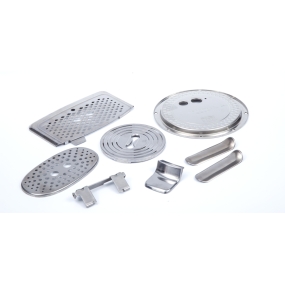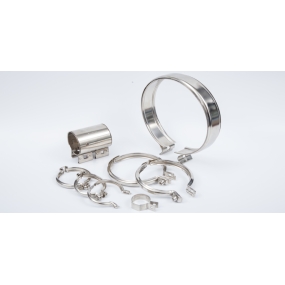Mechanical parts processing refers to the production of mechanical parts that meet manufacturing requirements through the processing of raw materials and the application of processing techniques. With the continuous development of technology and industrial production, the processing technology of mechanical parts is constantly improving, rapidly developing into a independent and complete industry. Detailed introduction to the processing of mechanical parts from the aspects of processing technology, processing accuracy, processing materials, processing equipment, etc.
1,Processing technology
Procedus machinationis parterum mechanicorum prima ex sequentibus gradibus consistit:
1. Analysis of part drawings: Before machining mechanical parts, it is necessary to analyze the part drawings, clarify the dimensions, materials, and machining requirements of the parts, and develop machining plans.
2. Material selection: According to the requirements of the parts, select corresponding materials such as carbon steel, stainless steel, aluminum alloy, etc., to ensure that the processed parts have the required strength and durability.
3. Design and drafting: Based on the processing drawings and process requirements, design and draft the processing technology to clarify various parameters such as material consumption, processing time, and equipment costs.
4. Preparation process: Prepare equipment, tools, and cutting fluids in a well ventilated workshop.
5. Cutting: Cutting materials on milling machines, lathes and other machines according to the machining drawings and process requirements.
6. Precision machining: Precision machining is performed on the processed parts to ensure their dimensional accuracy and surface quality.
7. Inspectio: Inspecte dimensiones et superficie qualitatem parterum processorum ut conformetur cum design requiribus.
2,Processing accuracy
The machining accuracy of mechanical parts refers to the difference in accuracy between the finished product and the design requirements. Makinelerin doğruluğu makinelerin araçları, araçları kesmek, fluidor kesmek ve materyaller gibi faktörlere bağlı. Precisio, stipendia, et repetitibilitate instrumentorum machinarum sunt principes factores accuracionem machinarum secundum. Qualitate, hardness, coating, and other treatments of cutting tools can also affect machining accuracy. Selection and quality of cutting fluid are also the main factors affecting machining accuracy. Integritate, difficilitate, et difficilitate materiarum procedere potest etiam precisitatem processere.
3,Processing materials
Materiales procedentes partibus mechanicis in principio steelis sunt, cum calore, coper, alloy aluminium, et plasticus quasi materia auxiliosa. Among them, carbon steel material has a simple process and low price, and is widely used in the procession of some mechanical parts. Materium fertilis stabilis habet altum qualitatem, corrosionem resistentiam, et suitum est ad productionem partium mechanicorum. Materium caloris habet bonam conductivitatem, conductivitatem thermalem et difficilem, facientem illum adequam ad fabricationem componentium electronicorum. Aluminum alloy is mainly used in the manufacture of large machinery such as airplanes and automobiles. It has low density, high strength and good surface properties, which can reduce the overall weight of the machine and improve mechanical performance.
4,Processing equipment
Mechanical parts processing equipment includes lathes, milling machines, center cutters, planers, grinders, electrical discharge machines, laser cutting machines, etc. Among them, lathes and milling machines are commonly used machines in machining, which can meet the processing needs of most parts. Medium tunica est arma quam metallum, lapidem metallum et ceteris materiales sequitur. Planer suitus est ad machinationem partes flat is, rectis, cam et ceteris formis. Grinding machines are suitable for high-precision machining and can manufacture parts with high positioning accuracy. Spark machining machines and laser cutting machines are rarely used, mainly for processing special materials and manufacturing various complex shaped parts.
Ex supra processionem parterum mechanicorum introducet. With the continuous advancement of technology and industrial production, the processing technology and equipment for mechanical parts will continue to improve, promoting the development of the mechanical parts processing industry.


 English
English Spanish
Spanish Arabic
Arabic Portuguese
Portuguese Belarusian
Belarusian Japanese
Japanese Russian
Russian Icelandic
Icelandic Bulgarian
Bulgarian Azerbaijani
Azerbaijani Estonian
Estonian Irish
Irish Polish
Polish Persian
Persian Boolean
Boolean Danish
Danish German
German French
French Filipino
Filipino Finnish
Finnish Korean
Korean Dutch
Dutch Galician
Galician Catalan
Catalan Czech
Czech Croatian
Croatian Latvian
Latvian Romanian
Romanian Maltese
Maltese Malay
Malay Macedonian
Macedonian Norwegian
Norwegian Swedish
Swedish Serbian
Serbian Slovak
Slovak Slovenian
Slovenian Swahili
Swahili Thai
Thai Turkish
Turkish Welsh
Welsh Urdu
Urdu Ukrainian
Ukrainian Greek
Greek Hungarian
Hungarian Italian
Italian Yiddish
Yiddish Indonesian
Indonesian Vietnamese
Vietnamese Haitian Creole
Haitian Creole Spanish Basque
Spanish Basque







